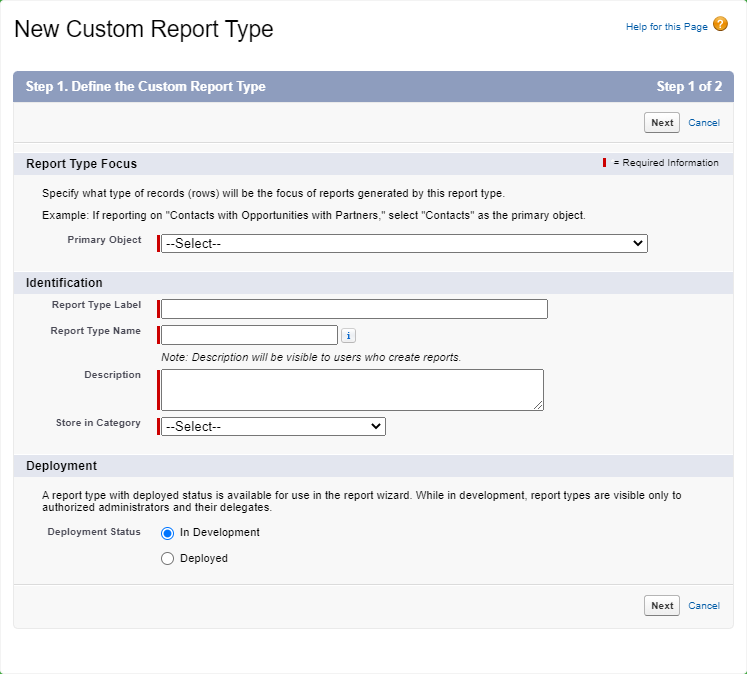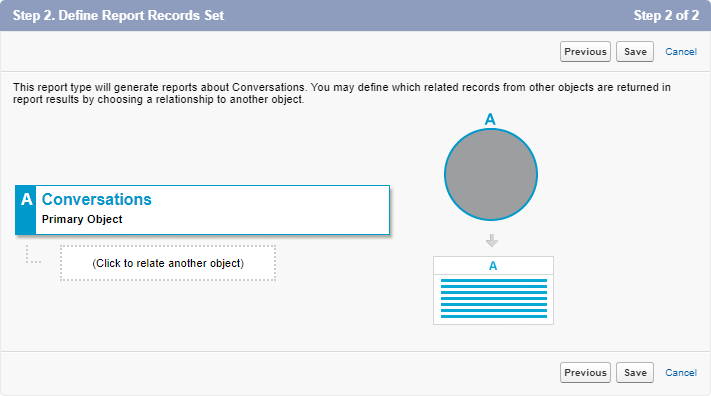Create a custom report type
-
In the HR Manager portal, go to Setup > Platform Tools > Feature Settings > Analytics > Reports & Dashboards > Report Types.
Sage People displays the Custom Report Types page. If you see a section titled What is a Custom Report Type on the page, select Continue.
-
On the All Custom Report Types page, select New Custom Report Type.
Sage People displays Step 1. Define the Custom Report Type:

-
Complete the fields in the Report Type Focus section as follows:
Field Description Primary Object Picklist.
Select Conversations.
-
Complete the fields in the Identification section as follows:
Field Description Report Type Label The name of the custom report type.
Label is displayed to users when they select a report type for a new report.
Report Type Name Automatically completed by Sage People based on the Report Type Label.
Must begin with a letter, contain alphanumeric characters and underscores only.
Description Enter the purpose and characteristics of this custom report type.
Description is displayed to users when they select a report type for a new report.
Store in Category Picklist. Select the category in which this custom report type is included. Categories are displayed on the Create Reports screen.
Typically Other Reports.
-
In the Deployment section, In Development is selected for Deployment Status by default. Changing the status to Deployed makes the custom report type available for all users.
-
If you are still developing the report type, leave status as In Development, and then select Next.
-
If you are ready to deploy the report type, change the status to Deployed, and then select Next.
Sage People displays Step 2. Define Report Records Set:

-
-
Select (Click to relate another object).
Sage People displays a B section for you to select the related object:

-
Define the A to B relationship:
-
select the picklist and choose Comments as the object
-
select Each "A" record must have at least one related "B" record
-
Select (Click to relate another object).
Sage People displays a C section for you to select the related object:

-
Define the B to C relationship:
-
select the picklist and choose Versions as the object
-
select Each "B" record must have at least one related "C" record
-
-
Select Save.
Sage People displays the details of the custom report type you just created. By default, all fields in the objects are included in the custom report type.
-
If you want to make changes to fields included in the report—add fields via lookup, or remove fields—select Add Layout. You can also create and edit sections. Select Save after you have made your changes.
For example, if you want to add fields from the Team Member object, you can access them via lookup by selecting Comments Fields in the selection panel, then Add fields related via lookup, and then Author, and then select the fields you want.
Create a report
-
In the HR Manager portal, go to Reports tab.
-
Select New Report.
-
On the Create Report dialog, select the All category, and then search for Conversations.
-
From the search results, select the custom report type created for Conversations, and then select Start Report.
If you get multiple search results, the Details section includes the objects in the report type, and the Fields section lists the fields available for reports in the report type.
-
On the report builder screen, select Filters from the left sidebar.
-
Change the default filters as follows:
-
Show Me: change to All conversations
-
Created Date: change to All Time or a custom time period
You can also add other filters.
-
-
Select the Outline tab. You can:
-
add and remove fields displayed in the report in the Columns section. You have access to all the fields included in the custom report type.
-
change the order of columns by dragging and dropping the column names in the list in the Columns section.
-
group rows in the report in the Groups section.
-
-
When you are happy with the report, select Save & Run and complete the fields to name the report and choose the folder where it is stored. Then select Save.